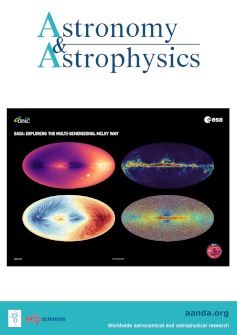The highly magnetic Wolf-Rayet binary HD 45166 resolved with VLTI/GRAVITY⋆
IF 5.4
2区 物理与天体物理
Q1 ASTRONOMY & ASTROPHYSICS
引用次数: 0
Abstract
HD 45166 was recently reported to be a long-period binary comprising a B7 V star and a highly magnetic (⟨B⟩=43.0 ± 0.5 kG) hot Wolf-Rayet-like component, dubbed a quasi Wolf-Rayet (qWR) star in the literature. While originally proposed to be a short-period binary, long-term spectroscopic monitoring suggested a 22.5 yr orbital period. With a derived dynamical mass of 2.03 ± 0.44 M⊙, the qWR component is the most strongly magnetized non-degenerate object ever detected and a potential magnetar progenitor. However, the long period renders the spectroscopic orbital solution and dynamical mass estimates uncertain, casting doubts on whether the qWR component is massive enough to undergo core collapse. Here, we spatially resolve the HD 45166 binary using newly acquired interferometric data obtained with the GRAVITY instrument of the Very Large Telescope Interferometer. Due to the calibrator star being a binary as well, we implemented a new approach for visibility calibration and tested it thoroughly using archival GRAVITY data. The newly calibrated HD 45166 data revealed the unmistakable presence of a companion to the qWR component with an angular separation of 10.9 ± 0.1 mas (which translates to a projected physical separation of 10.8 ± 0.4 au), consistent with the long-period orbit. We obtained a model-independent qWR mass using interferometric and spectroscopic data together. This observation robustly confirms that HD 45166 is truly a long-period binary and provides an anchor point for accurate mass determination of the qWR component with further observations.求助全文
约1分钟内获得全文
求助全文
来源期刊

Astronomy & Astrophysics
地学天文-天文与天体物理
CiteScore
10.20
自引率
27.70%
发文量
2105
审稿时长
1-2 weeks
期刊介绍:
Astronomy & Astrophysics is an international Journal that publishes papers on all aspects of astronomy and astrophysics (theoretical, observational, and instrumental) independently of the techniques used to obtain the results.
 求助内容:
求助内容: 应助结果提醒方式:
应助结果提醒方式:


